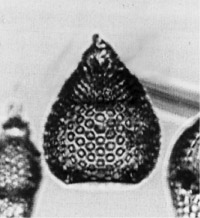 Theocotyle
conica Foreman
Theocotyle
conica Foreman Theocotyle
conica Foreman
Theocotyle
conica ForemanTheocotyle (Theocotyle) cryptocephala(?) conica Foreman, 1973, p.440, pl.4, fig.11, pl.12, figs.19-20
Theocotyle conica Sanfilippo and Riedel, 1982, p.177, pl.2, fig.13 (with synonymy)
Similar in all respects to T. cryptocephala except abdomen has greatest width distally rather than medially (Sanfilippo and Riedel, 1982).
Based on 25 specimens. Maximum length excluding horn 130-175 µm, of abdomen 65-105 µm. Maximum width 105-135 µm (Sanfilippo and Riedel, 1982).
T. conica is distinguished from its ancestor T. cryptocephala, which it accompanies through part of its range, by having its greatest width distally, and from T. ficus by its smaller size. Early forms of T. ficus whose size might coincide with that of T. conica are ovate in general form, rather than distinctly conical. It is distinguished from T. venezuelensis by having a campanulate thorax and not such a distinct change of contour at the lumbar stricture (Sanfilippo et al., 1985).
The abdomen is always distinctly conical, with pores varying in size to twice as large as those on the thorax. Some early specimens have vestigial wings (Sanfilippo et al., 1985).
T. conica has a short range in the middle middle Eocene. Its evolutionary transition from Theocotyle cryptocephala lies within the Dictyoprora mongolfieri Zone. Its morphotypic last appearance lies within the Thyrsocyrtis triacantha Zone.
T. conica terminates the lineage T. nigriniae - T. conica. The intermediate form is T. cryptocephala.